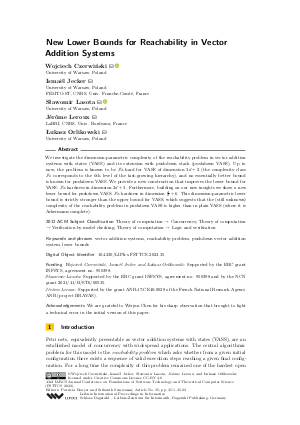New Lower Bounds for Reachability in Vector Addition Systems
Authors
Wojciech Czerwiński  ,
Ismaël Jecker,
Sławomir Lasota
,
Ismaël Jecker,
Sławomir Lasota  ,
Jérôme Leroux,
Łukasz Orlikowski
,
Jérôme Leroux,
Łukasz Orlikowski
-
Part of:
Volume:
43rd IARCS Annual Conference on Foundations of Software Technology and Theoretical Computer Science (FSTTCS 2023)
Part of: Series: Leibniz International Proceedings in Informatics (LIPIcs)
Part of: Conference: IARCS Annual Conference on Foundations of Software Technology and Theoretical Computer Science (FSTTCS) - License:
 Creative Commons Attribution 4.0 International license
Creative Commons Attribution 4.0 International license
- Publication Date: 2023-12-12
File

PDF
LIPIcs.FSTTCS.2023.35.pdf
- Filesize: 0.92 MB
- 22 pages
Document Identifiers
Subject Classification
ACM Subject Classification
- Theory of computation → Concurrency
- Theory of computation → Verification by model checking
- Theory of computation → Logic and verification
Keywords
- vector addition systems
- reachability problem
- pushdown vector addition system
- lower bounds
Metrics
- Access Statistics
-
Total Accesses (updated on a weekly basis)
0PDF Downloads0Metadata Views
Abstract
We investigate the dimension-parametric complexity of the reachability problem in vector addition systems with states (VASS) and its extension with pushdown stack (pushdown VASS). Up to now, the problem is known to be F_d-hard for VASS of dimension 3d+2 (the complexity class F_d corresponds to the kth level of the fast-growing hierarchy), and no essentially better bound is known for pushdown VASS. We provide a new construction that improves the lower bound for VASS: F_d-hardness in dimension 2d+3. Furthermore, building on our new insights we show a new lower bound for pushdown VASS: F_d-hardness in dimension d/2 + 6. This dimension-parametric lower bound is strictly stronger than the upper bound for VASS, which suggests that the (still unknown) complexity of the reachability problem in pushdown VASS is higher than in plain VASS (where it is Ackermann-complete).
Cite As Get BibTex
Wojciech Czerwiński, Ismaël Jecker, Sławomir Lasota, Jérôme Leroux, and Łukasz Orlikowski. New Lower Bounds for Reachability in Vector Addition Systems. In 43rd IARCS Annual Conference on Foundations of Software Technology and Theoretical Computer Science (FSTTCS 2023). Leibniz International Proceedings in Informatics (LIPIcs), Volume 284, pp. 35:1-35:22, Schloss Dagstuhl – Leibniz-Zentrum für Informatik (2023)
https://doi.org/10.4230/LIPIcs.FSTTCS.2023.35
BibTex
@InProceedings{czerwinski_et_al:LIPIcs.FSTTCS.2023.35,
author = {Czerwi\'{n}ski, Wojciech and Jecker, Isma\"{e}l and Lasota, S{\l}awomir and Leroux, J\'{e}r\^{o}me and Orlikowski, {\L}ukasz},
title = {{New Lower Bounds for Reachability in Vector Addition Systems}},
booktitle = {43rd IARCS Annual Conference on Foundations of Software Technology and Theoretical Computer Science (FSTTCS 2023)},
pages = {35:1--35:22},
series = {Leibniz International Proceedings in Informatics (LIPIcs)},
ISBN = {978-3-95977-304-1},
ISSN = {1868-8969},
year = {2023},
volume = {284},
editor = {Bouyer, Patricia and Srinivasan, Srikanth},
publisher = {Schloss Dagstuhl -- Leibniz-Zentrum f{\"u}r Informatik},
address = {Dagstuhl, Germany},
URL = {https://drops.dagstuhl.de/entities/document/10.4230/LIPIcs.FSTTCS.2023.35},
URN = {urn:nbn:de:0030-drops-194088},
doi = {10.4230/LIPIcs.FSTTCS.2023.35},
annote = {Keywords: vector addition systems, reachability problem, pushdown vector addition system, lower bounds}
}
Author Details
Funding
Wojciech Czerwiński, Ismaël Jecker and Łukasz Orlikowski: Supported by the ERC grant INFSYS, agreement no. 950398.
- Lasota, Sławomir: Supported by the ERC grant INFSYS, agreement no. 950398 and by the NCN grant 2021/41/B/ST6/00535.
- Leroux, Jérôme: Supported by the grant ANR-17-CE40-0028 of the French National Research Agency ANR (project BRAVAS).
Acknowledgements
We are grateful to Weijun Chen for his sharp observation that brought to light a technical error in the initial version of this paper.
References
-
Mohamed Faouzi Atig and Pierre Ganty. Approximating Petri Net Reachability Along Context-free Traces. In Proceedings of FSTTCS 2011, volume 13 of LIPIcs, pages 152-163, 2011.

-
Michael Blondin, Alain Finkel, Stefan Göller, Christoph Haase, and Pierre McKenzie. Reachability in Two-Dimensional Vector Addition Systems with States Is PSPACE-Complete. In Proceedings of LICS 2015, pages 32-43, 2015.

-
Wojciech Czerwinski, Slawomir Lasota, Ranko Lazic, Jérôme Leroux, and Filip Mazowiecki. The reachability problem for Petri nets is not elementary. In Proceedings of STOC 2019, pages 24-33. ACM, 2019.

-
Wojciech Czerwinski, Slawomir Lasota, Ranko Lazic, Jérôme Leroux, and Filip Mazowiecki. The Reachability Problem for Petri Nets Is Not Elementary. Journal of the ACM, 68(1):7:1-7:28, 2021.

-
Wojciech Czerwinski and Lukasz Orlikowski. Reachability in Vector Addition Systems is Ackermann-complete. In Proceedings of FOCS 2021, pages 1229-1240. IEEE, 2021.

-
Wojciech Czerwinski and Lukasz Orlikowski. Lower Bounds for the Reachability Problem in Fixed Dimensional VASSes. In Proceedings of LICS 2022, pages 40:1-40:12. ACM, 2022.

-
Matthias Englert, Piotr Hofman, Slawomir Lasota, Ranko Lazic, Jérôme Leroux, and Juliusz Straszynski. A lower bound for the coverability problem in acyclic pushdown VAS. Inf. Process. Lett., 167:106079, 2021.

-
Matthias Englert, Ranko Lazić, and Patrick Totzke. Reachability in Two-Dimensional Unary Vector Addition Systems with States is NL-Complete. In Proceedings of LICS 2016, pages 477-484. ACM, 2016.

-
Christoph Haase, Stephan Kreutzer, Joël Ouaknine, and James Worrell. Reachability in succinct and parametric one-counter automata. In Proceeding of CONCUR 2009, volume 5710, pages 369-383. Springer, 2009.

-
Slawomir Lasota. Improved Ackermannian Lower Bound for the Petri Nets Reachability Problem. In Proceedings of STACS 2022, volume 219 of LIPIcs, pages 46:1-46:15. Schloss Dagstuhl - Leibniz-Zentrum für Informatik, 2022.

- Jérôme Leroux. The reachability problem for petri nets is not primitive recursive. CoRR, abs/2104.12695, 2021. URL: https://arxiv.org/abs/2104.12695.
-
Jérôme Leroux. The Reachability Problem for Petri Nets is Not Primitive Recursive. In Proceedings of FOCS 2021, pages 1241-1252. IEEE, 2021.

-
Jérôme Leroux, M. Praveen, and Grégoire Sutre. Hyper-Ackermannian bounds for pushdown vector addition systems. In Proceedings of CSL-LICS 2014, pages 63:1-63:10. ACM, 2014.

-
Jérôme Leroux and Sylvain Schmitz. Reachability in Vector Addition Systems is Primitive-Recursive in Fixed Dimension. In Proceedings of LICS 2019, pages 1-13. IEEE, 2019.

-
Jérôme Leroux, Grégoire Sutre, and Patrick Totzke. On the Coverability Problem for Pushdown Vector Addition Systems in One Dimension. In Proceedings of ICALP 2015, volume 9135 of Lecture Notes in Computer Science, pages 324-336. Springer, 2015.

-
Richard J. Lipton. The Reachability Problem Requires Exponential Space. Technical report, Yale University, 1976.

-
Marvin L. Minsky. Computation: Finite and Infinite Machines. Prentice-Hall Series in Automatic Computation. Prentice-Hall, 1967.

-
Sylvain Schmitz. Complexity Hierarchies beyond Elementary. TOCT, 8(1):3:1-3:36, 2016.

